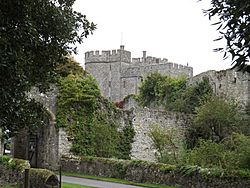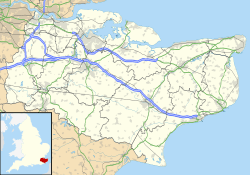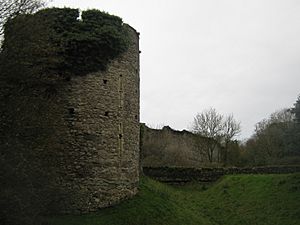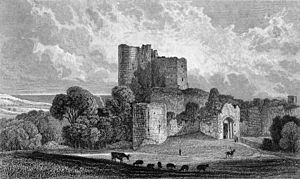Saltwood Castle facts for kids
Quick facts for kids Saltwood Castle |
|
|---|---|
| Kent in England | |

Saltwood Castle in 2013
|
|
|
Shown within Kent
|
|
| Coordinates | 51°4′54.64″N 1°5′3.72″E / 51.0818444°N 1.0843667°E |
| Site information | |
| Owner | Private |
| Open to the public |
No |
| Site history | |
| Materials | Stone |
Saltwood Castle is an old castle located in the village of Saltwood, about 2 kilometers north of Hythe, Kent, England. It was first built in the 11th century and then made bigger in the 13th and 14th centuries.
After the Normans took over England, the castle became the property of the Archbishop of Canterbury named Lanfranc. It stayed with the archbishops for a long time, until 1540. At that point, Thomas Cranmer, who was the archbishop, had to give it to Henry VIII, the King.
Saltwood Castle is famous for a very important event. It's believed to be the place where four knights planned to kill Thomas Becket in 1170. By the 1800s, much of the castle was in ruins. However, parts of it were fixed up in the 1880s and 1930s so people could live there again.
Later, in the late 1800s, an ancestor of the journalist Bill Deedes bought the castle. Bill Deedes grew up there. In the 1900s, it was sold to Sir Martin Conway, who had it restored. In 1953, a famous art historian named Kenneth Clark bought the castle. His son, Alan Clark, who was a politician, later lived there. Today, it is still a private home belonging to Alan Clark's widow, Jane Clark. Saltwood Castle is a very important historic building, listed as a Grade I building.
Contents
History of Saltwood Castle
Early Days of the Castle
The castle was probably built on an old Roman site. However, tools and copper found nearby show that people lived in this area even earlier, during the Bronze Age.
The history of the castle's location goes back to 488 CE. At that time, Aesc, the son of Hengist and King of Kent, built a castle here. The first written record of the castle is from a document by King Egbert in 833.
The land around Saltwood was given to a church group in Canterbury in 1026. When William of Normandy took over England, Saltwood became part of a chain of important lands. These lands were given to powerful knights along the south coast of England. The castle you see today was built in the 1100s in the Norman style. More work was done on it over the next two centuries. For a while, it was the home of Henry of Essex, a powerful official in England.
The Story of Thomas Becket
Thomas Becket was a very important church leader. He asked King Henry II to give Saltwood Castle back to the Church. But King Henry II gave it to one of his loyal barons, Ranulf de Broc, instead.
This decision by the King might have played a part in the sad story of Thomas Becket. It was at Saltwood Castle, on December 28, 1170, that four knights are believed to have planned Becket's death. The very next day, they killed him at Canterbury Cathedral, which is about 24 kilometers away. The four knights were Hugh de Moreville, Reginald Fitzurse, William de Tracey, and Richard le Breton.
After Becket was killed, the castle was given back to the archbishop of Canterbury. The castle's gatehouse has special openings for guns, built between 1385 and 1394. These were likely designed by Henry Yevele, who was known for his skills in building castles to defend against artillery.
More Recent History
Saltwood Castle remained church property until King Henry VIII took over. He seized both Hythe and Saltwood for the Crown. The castle was badly damaged by an earthquake in 1580.
However, it was repaired in the 1800s and became a home again for the Archbishop of Canterbury. The gatehouse has been used as a home ever since.
The castle was the childhood home of Bill Deedes, a well-known journalist and politician. In 1955, it was bought by Kenneth Clark, a famous art historian. His son, Alan Clark, who was also a politician and wrote diaries, later lived there. After Alan Clark passed away, he was buried on the castle grounds. Saltwood Castle is still owned by the Clark family today.





